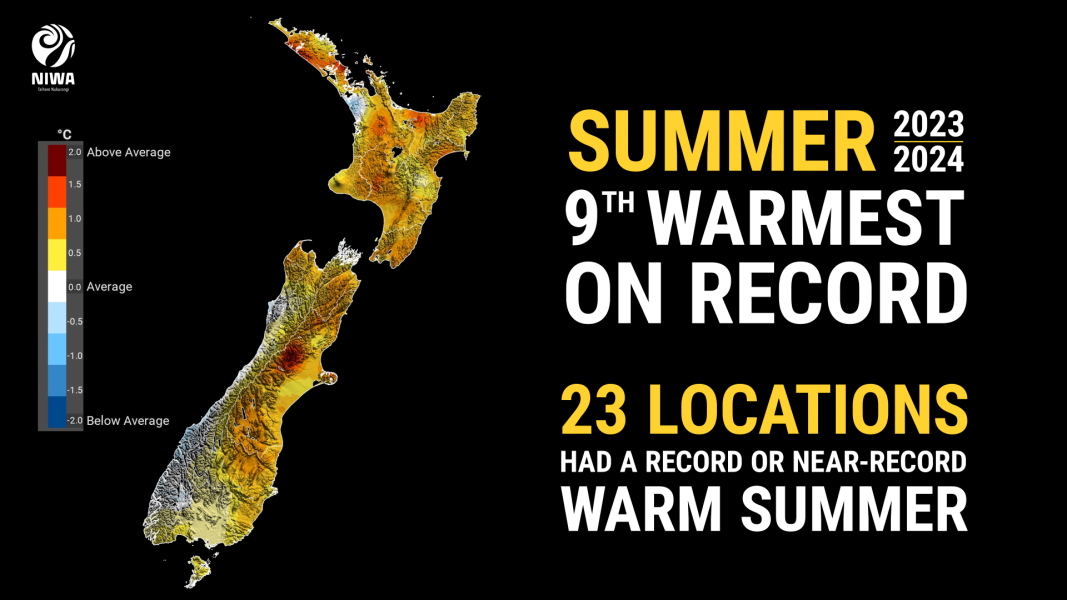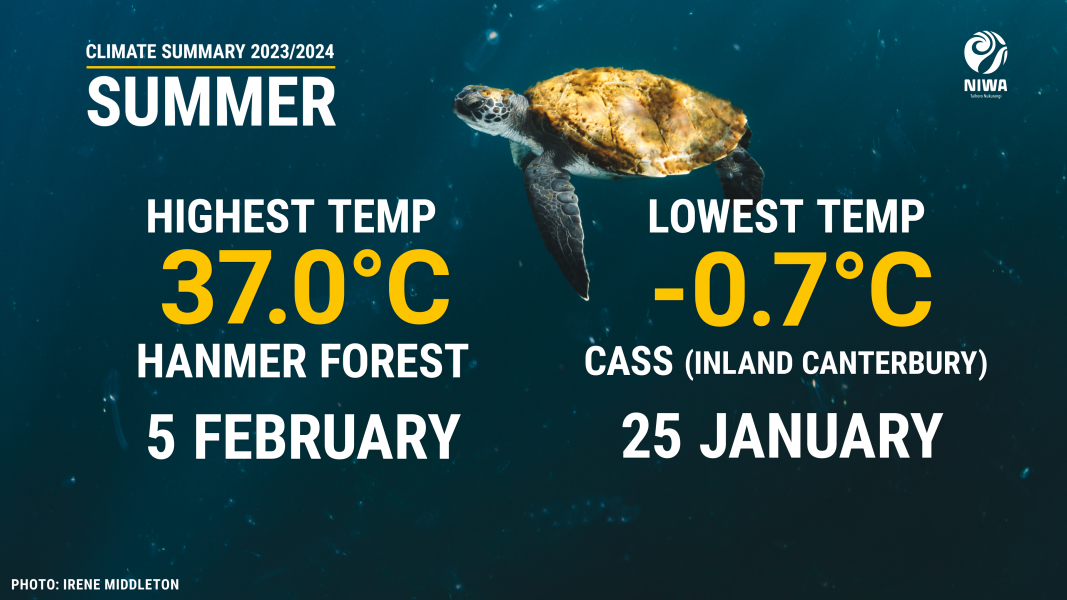A warm summer overall, dry for many parts of the country
| Temperature | Summer temperatures were above average (0.51-1.20°C above average) or well above average (>1.20°C above average) for most of the country. The exception was western and southern parts of the South Island where temperatures were near average (±0.50°C of average). |
| Rainfall | Rainfall was below normal (50-79% of normal) or well below normal (<50% of normal) for northern, eastern, and inland parts of the South Island, as well as for southern and western parts of the North Island, eastern Bay of Plenty, and much of Northland. Rainfall was above normal (120-149% of normal) or well above normal (>149% of normal) across central parts of the North Island from Waitomo east to parts of Hawke’s Bay and Gisborne, as well as for western and southern parts of the South Island. |
| Soil moisture | At the end of summer, soil moisture levels were lower than normal in parts of Northland, Auckland, Coromandel Peninsula, eastern Bay of Plenty, Gisborne, southern Hawke’s Bay, eastern Taranaki, Manawatū-Whanganui, Wellington-Wairarapa, eastern Tasman, Nelson, Marlborough, Canterbury, and eastern Otago. Normal or above normal soil moisture was observed elsewhere. |
Overview
Summer 2023-24 was characterised by higher-than-normal air pressure over and east of the North Island, and lower-than-normal air pressure to the south of the country. This resulted in more westerly winds than normal over the South Island and lower North Island, which is characteristic of the strong, but waning, El Niño event in the equatorial Pacific.
It was a warm summer overall for most of Aotearoa New Zealand. Temperatures were above average (0.51-1.20°C above average) or well above average (>1.20°C above average) throughout the North Island, as well as for northern, eastern, and inland parts of the South Island. Near average temperatures (±0.50°C of average) were observed in western and southern parts of the South Island, while no areas observed below average temperatures (0.51-1.20°C below average). Summer 2023-24 was the ninth-warmest summer on record. The nationwide average temperature was 17.6°C. This was 0.8°C above the 1991-2020 summer average from NIWA’s seven station temperature series which begins in 1909.
Summer rainfall was below normal (50-79% of normal) or well below normal (<50% of normal) for northern, eastern, and inland parts of the South Island, as well as for southern and western parts of the North Island, eastern Bay of Plenty, and much of Northland. According to the New Zealand Drought Index, very dry or extremely dry conditions were present by the end of the season in Northland, East Cape, southern Manawatū-Whanganui, Wellington-Wairarapa, eastern Tasman, Nelson, Marlborough, North Canterbury, and north-east Otago. The prevalence of these dry conditions contributed to several significant wildfires (see Highlights and extreme events section for more details). In contrast, rainfall was above normal (120-149% of normal) or well above normal (>149% of normal) across central parts of the North Island from Waitomo east to parts of Hawke’s Bay and Gisborne, as well as for western and southern parts of the South Island.
Further highlights for summer 2023-24:
- The highest temperature was 37.0°C, observed at Hanmer Forest on 5 February.
- The lowest temperature was -0.7°C, observed at Cass (inland Canterbury) on 25 January.
- The highest 1-day rainfall was 330 mm, recorded at Milford Sound on 19 January.
- The highest wind gust was 172 km/h, observed at South West Cape on 9 December.
- Of the available, regularly reporting sunshine observation sites, the sunniest four locations so far in 2024 are wider Nelson (618 hours), Tasman (612 hours), Marlborough (604 hours), and Taranaki (595 hours).
- Of the six main centres in summer 2023-24, Auckland and Tauranga were the equal-warmest, Tauranga was the sunniest and wettest, Christchurch was the driest, and Dunedin was the coolest and least sunny.




